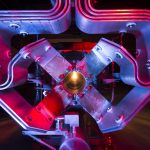From Big Think, Feb. 6, 2023: For the first time, the proton’s size and structure was measured using Fermilab’s MINERVA detector by studying proton/neutrino interactions. This new method, which studies weak force interactions, is a first step in which scientists can use to better understand the laws of the Universe.
Author Archive
From National Geographic (Poland), Feb. 2, 2023: A group of 150 scientists, including researchers from Fermilab and the University of Chicago, has published one of the most precise measurements of the distribution of matter in the Universe. The analysis is groundbreaking because it used data from two very different telescope surveys and it indicated that something is missing in the current standard model of the universe.
From Science Daily, Feb. 1, 2023: Yesterday, Nature posted new research which used a beam of neutrinos for the first time to investigate the structure of protons. With Fermilab’s MINERvA detector, scientists were able to precisely measure the proton’s size and structure using neutrinos with data gathered from thousands of neutrino-hydrogen scattering events.
From Big Think, Jan. 31, 2023: Fermilab researchers are part of a group who studied analysis from the South Pole Telescope and the Dark Energy Survey in a series of three scientific papers describing the expansion history of the Universe is tells a confusing tale. The predictions and measurements disagree slightly, it could be a hint that our theories about the Universe need to be revised.
For the first time, particle physicists have been able to precisely measure the proton’s size and structure using neutrinos with data gathered from thousands of neutrino-hydrogen scattering events collected by MINERvA, a particle physics experiment at the U.S. Department of Energy’s Fermi National Accelerator Laboratory.
From Physics, Jan. 31, 2023: Fermilab scientists are part of a group of researchers using cross-correlation measurements combining data from the Dark Energy Survey and the South Pole Telescope to determine cosmological parameters with greater precision. The analysis involved more than 150 researchers with results published as a set of three articles in Physical Review D.
From Big Think, Jan. 25, 2023: How old is the universe? Don Lincoln discusses the Methuselah Star measure versus the Big Bang theory.
From Phys.org, Jan. 25, 2023: Researchers at Fermilab, Northwestern University and Stanford University recently demonstrated an entirely new method for searching for meV dark matter. The group is testing a hypothesis that when the rest energy of a dark photon matches the energy splitting of the two lowest cyclotron levels, the first state of the electron cyclotron will be excited.
From CERN, Jan. 20, 2023: CERN is celebrating the completion of civil-engineering work for the High-Luminosity Large Hadron Collider. This will improve its performance by increasing the number of particle collisions and boosting the potential for discoveries. The HL-LHC is expected to start operating in 2029.
From Yahoo News, Jan. 20, 2023: A small group of Fashion Studies students and COD Fashion Studies Professor Eva Stevens, are working in collaboration with Fermilab engineers to design Personal Protective Equipment for Spot who works in radioactive and contaminated areas.

